Contents
Breeders bred the variety of sweet strawberries Capri for the sweet tooth. The berries are so saturated with sugar that sometimes you don’t even feel the taste of acid. Gardeners and farm owners have fallen in love with Capri strawberries for stable, long-term fruiting and high yields.
Inference history

Capri is an innovative remontant strawberry variety. The culture was bred by Italian breeders. The parents were CIVRI-30 and R6-R1–26. Despite the fact that Capri is a novelty, the variety managed to spread to the territory of the Federation and other countries of the world.
Description
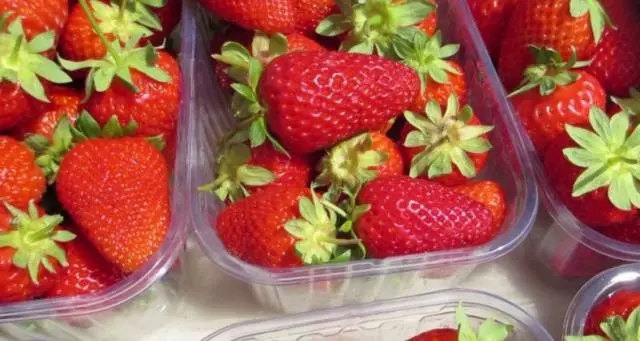
Capri strawberry bushes of medium height. The leaves do not create a strong thickening. Peduncles are strong, do not fall to the ground. Inflorescences attract bees with a large amount of pollen. A positive feature of the Capri variety is its long flowering. The berry grows large, weighing at least 40 g. The shape of the fruit is cone-shaped. The skin is glossy. The color is bright red with burgundy hues. The nose of the berry in the stage of technical maturity is orange.
The pulp of the berry is quite dense, but this does not prevent it from being tender and juicy. The firm structure increases the transportability as well as the preservation of the fruit. This quality is highly valued by farmers who grow Capri strawberries for sale. Berry even at the stage of technical maturity contains a lot of sugar. The fruits do not lose their sweetness in rainy summers. The yield of remontant strawberries reaches 2 kg of berries per bush.
The short peak yield is due to the long fruiting. Strawberries ripen in waves from late June to mid-November. Berries deplete mother bushes, shortening their life cycle.
Advantages and disadvantages of the variety
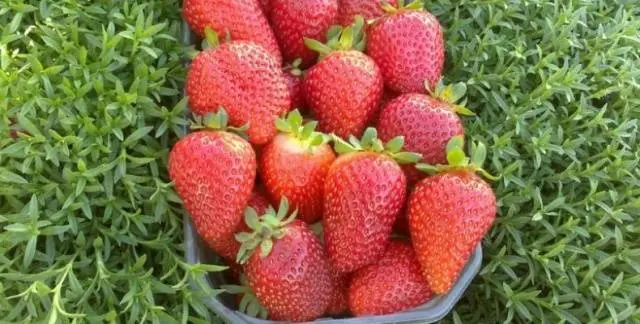
| Advantages | Disadvantages |
| Continuous long fruiting | A small number of whiskers complicates the propagation of the variety |
| High yield up to 2 kg per bush | The culture needs abundant watering and top dressing. |
| Bushes are frost-resistant, disease-resistant | Bushes develop well with frequent mulching and loosening of the soil |
| Berries can be transported and stored | |
| Bushes of compact size | |
| The plant is drought tolerant | |
| The sweetness in the berries persists in the rainy summer |
A feature of the Capri variety is the survival of the bush in the sun. The plant will remain alive even without shading, but there will be no flower stalks. It is for a good harvest that strawberries need abundant watering.
Methods of reproduction

The remontant strawberry of the Italian variety Capri is able to reproduce by mustache, dividing the bush and seeds.
Mustache
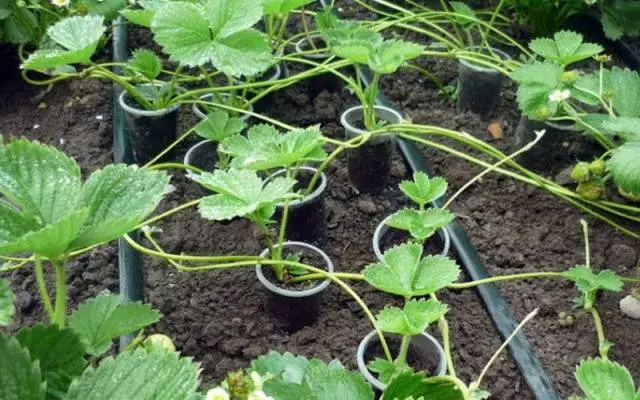
A feature of the Capri variety is a small mustache formation. For caring for a garden bed, this is a plus, but with reproduction a problem is created. However, there is a mustache, which means that you can independently increase the number of bushes in the garden.
When the mother plant throws out a long mustache with a developed rosette, the soil is loosened between the rows. It is important to remove all weeds from the garden. The lower part of the outlet is slightly buried in the ground and watered frequently. By autumn, roots will grow. The socket can be cut off from the mustache and transplanted as a full-fledged seedling.
By dividing the bush
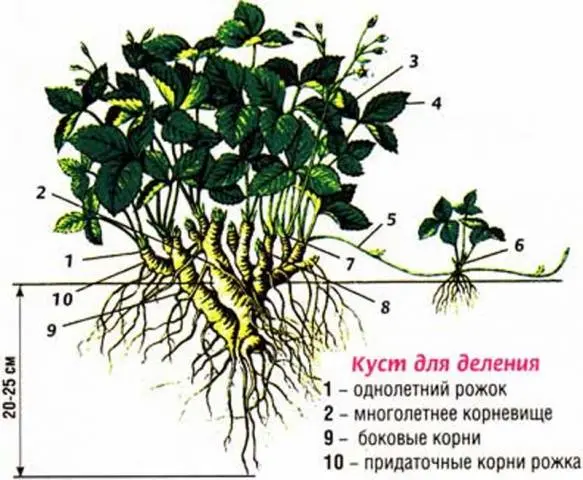
An adult plant at 2–3 years of age is propagated by dividing the bush. Strawberries are dug up from the garden in spring before flowering or in autumn after fruiting. The bush is divided into several parts so that each outlet has at least 3 leaves and a developed root. Each Capri seedling is planted in a garden bed.
Cultivation from seeds
You can propagate or re-introduce the Italian remontant variety Capri by seeds. You will have to grow seedlings in boxes, peat tablets or flower pots.
In short, to obtain seeds at home, large, overripe berries without visible damage are selected in the garden. The skin is cut from the fruit with a knife, dried in the sun and the grains are collected.
The sowing time for Capri strawberry seeds is determined individually according to the weather conditions of the region. Usually this is the period from February to early April. Before sowing, the seeds are subjected to stratification – cold hardening.
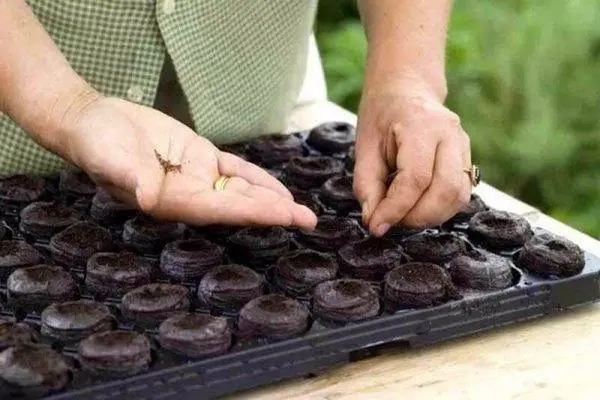
You can sow in peat tablets, soaking them in water before that. The traditional method is based on immersing the grains into the ground. You can sow immediately in individual cups or in common boxes. In the second case, after growing three leaves on a seedling, the plants dive into a separate container.

If the seeds of the Capri strawberry variety did not germinate, then the technology for growing seedlings was violated. The problem is solved only by re-sowing.
Landing
There are no special secrets for planting remontant Capri strawberries. The procedure is typical, as for all other varieties.
How to choose seedlings
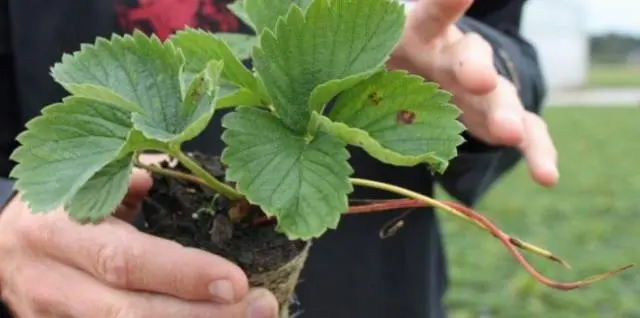
Quality seedlings of remontant strawberries of the Italian variety Capri are determined by their appearance. The horn of a good plant is at least 7 mm thick. The leaves are wide, juicy, without damage and at least three pieces.
The length of the open root system of the seedling should be more than 7 cm. If the plant is sold in a cup or peat tablet, inspect the entire lump. It should be braided with white roots.
Site selection and preparation of soil
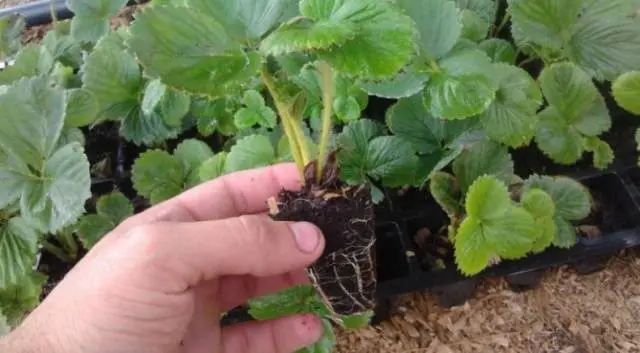
The Capri variety does not belong to demanding crops, but there are nuances in choosing a place and soil composition. Strawberries love loamy fertile soils with neutral acidity. The plant will take root well in the area where alfalfa, green salads, white cabbage grew last year.
The close location of groundwater is detrimental to culture. If there is a swampy area on the site, an elevation is poured for the beds. The Capri strawberry plantation is located in a sunny area. If it is impossible to provide good growing conditions, the culture can be grown on a vertical bed by planting plants in flower pots.
Landing scheme
When planting seedlings of the remontant variety Capri, a space of 30 cm is left between the bushes. The row spacing is made about 45 cm. Since the variety forms a small mustache, dense planting of plants is allowed in order to save space.
Care
To get a good harvest, Capri strawberries need care. The procedures are all classic: watering, fertilizing, pest control, weeding.
Care in the spring
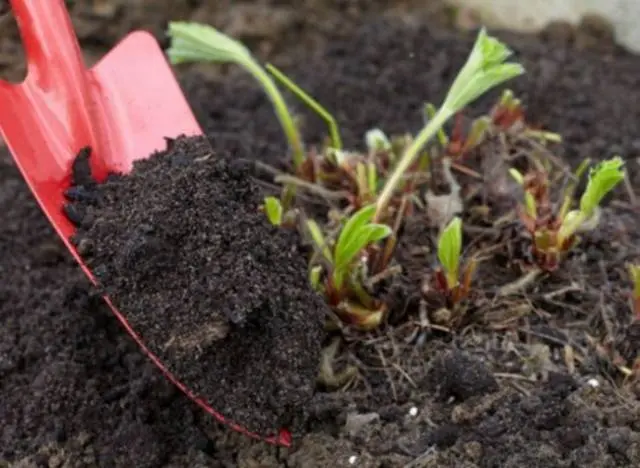
Strawberries deliver the most trouble to the gardener in the spring. Caring for Capri involves the following steps:
- After the snow melts, inspect the bushes. Cut off dry, damaged leaves, the remaining old flower stalks.
- Clear the bed of old mulch and winter shelter. The soil is loosened to a depth of 3 cm. Strawberries are fed with ashes.
- If roots are visible on the surface, Capri strawberry bushes spud.
- In order for the plants to come to life and grow, strawberries are watered abundantly from early spring.
- From top dressing, Capri loves organic. Under each bush pour 0,5 l of a solution of mullein 1:3 or chicken manure 1:10.
- The buds have not yet blossomed, strawberry bushes are treated for prevention with a solution of copper sulphate.
- The soil around the plants is covered with peat, sawdust or small straw. Mulch will retain moisture, prevent weed growth, and become organic fertilizer over time.
Be sure to spring strawberries need mineral top dressing. Saltpeter is usually used.
Watering and mulching
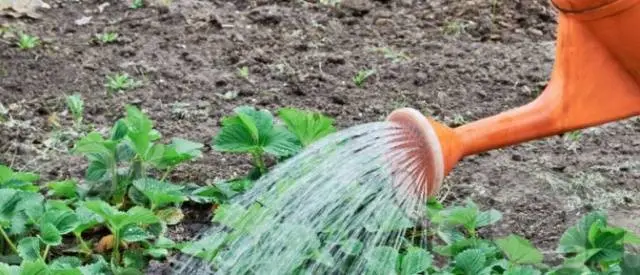
Although drought tolerant, the remontant Capri likes abundant watering. Especially a lot of water is required during the formation of berries and before flowering. However, the formation of swamps should not be allowed. After watering, the soil is mulched to retain moisture.
Feeding by month
During the season, the Capri variety requires three mandatory top dressings with mineral complexes. It depends on the size of the berries and taste.
For review, a table is provided that describes preparations for strawberries and the technology for their use.

Preparation for winter
In autumn, strawberry bushes are prepared for wintering. Plants are provided with shelter from straw or pine branches.
Diseases and methods of struggle
The variety of remontant strawberry Capri is resistant to diseases, but may be affected by gray rot. Occasionally, verticillium wilt appears.

Pests and ways to deal with them
Sweet strawberries, juicy foliage are not averse to eating pests. First of all, these are ants, slugs and snails.
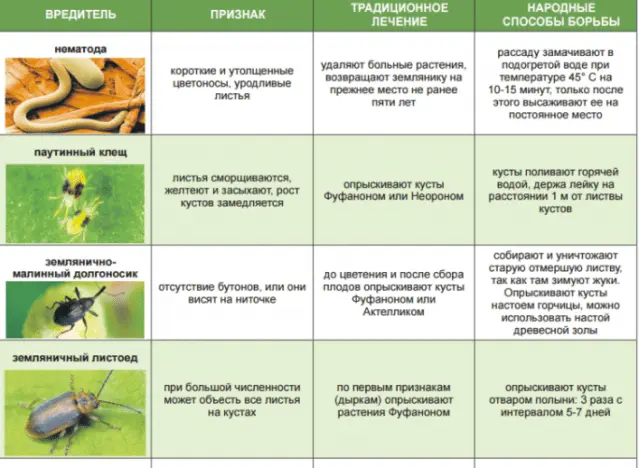
Features of growing in pots
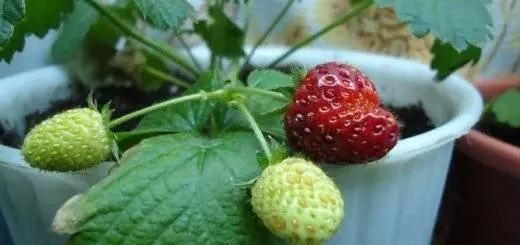
Capri variety can be grown in flower pots on a high bed or indoors. In the second case, artificial pollination with a brush is required, and in summer the strawberries are taken out to the balcony.
Conclusion
The remontant Capri strawberry is an ideal variety for sweet tooth and commercial gardeners.









